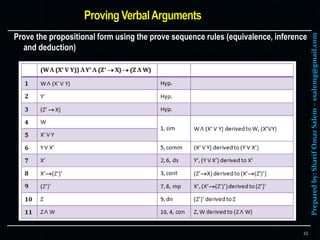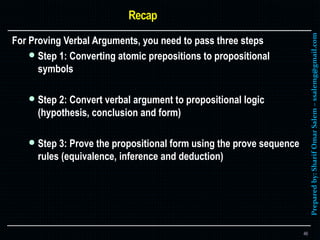#3 formal methods – propositional logic
- 1. Preparedby:SharifOmarSalem–[email protected] Prepared by: Sharif Omar Salem – [email protected] 0
- 2. Preparedby:SharifOmarSalem–[email protected] Prepositional logic is a formal system of representing knowledge Prepositional logic has: Syntax – what the allowable expressions are. Structure of the sentence. Semantics – what the expressions mean. Meaning Proof theory – how conclusions are drawn from a set of statements. Reasoning. 1
- 3. Preparedby:SharifOmarSalem–[email protected] Symbols represent facts E.g. “Penguins need a cold environment” is a fact That could be represented by the symbol P Each fact is called an atomic formulas or atoms Atomic propositions can be combined using logical connectives – Order of precedence: ¬ ∧ ∨ → ↔ 2
- 4. Preparedby:SharifOmarSalem–[email protected] These symbols P, Q,………. etc used to represent propositions, are called atomic formulas, or simply atoms. To express more complex propositions such as the following compound proposition, we use logical connectives such as → (if-then or imply): “if car brake pedal is pressed, then car stops within five seconds.” This compound proposition is expressed in propositional logic as: P → Q 3
- 5. Preparedby:SharifOmarSalem–[email protected] We can combine propositions and logical connectives to form complicated formulas. Well-Formed Formulas: Well-formed formulas in propositional logic are defined recursively as follows: 1. An atom is a formula. 2. If F is a formula, then (¬F) is a formula, where ¬ is the not operator. 3. If F and G are formulas, then (F ∧ G), (F ∨ G), (F → G),and (F ↔G) are formulas. (∧ is the and operator, ∨ is the or operator , ↔ stands for if and only if or iff.) 4. All formulas are generated using the above rules. 4
- 6. Preparedby:SharifOmarSalem–[email protected] Logic is made up sentences P might be a sentence P ∧ Q is also a sentence If we know the truth values of P and Q, we can work out the truth value of the sentence. If P and Q are both true then P ∧ Q is true, otherwise it is false Can use truth tables to ascertain the truth of a sentence 5
- 7. Preparedby:SharifOmarSalem–[email protected] An interpretation of a propositional formula G is an assignment of truth values to the atoms A1,... , An in G in which every Ai is assigned either T or F, but not both. The Figure shows the truth table for several simple formulas. 6
- 8. Preparedby:SharifOmarSalem–[email protected] A literal is an atomic formula or the negation of an atomic formula. A clause is a wff express a fact (premises or conclusion). A clause set is a group of clause express an argument. A formula is in conjunctive normal form (CNF) if it is a conjunction of disjunction of literals. A formula is in disjunctive normal form (DNF) if it is a disjunction of conjunction of literals. 7
- 9. Preparedby:SharifOmarSalem–[email protected] P - represents the fact “Penguins eat fish” Q - represents the fact “Penguins like fish” P ∧ Q – Penguins eat fish and penguins like fish P ∨ Q – Penguins eat fish or penguins like fish ¬ Q – Penguins do not like fish P → Q Penguins eat fish therefore penguins like fish. If penguins eat fish then penguins like fish. P ↔ Q Penguins eat fish therefore penguins like fish and penguins like fish therefore penguins eat fish. 8
- 10. Preparedby:SharifOmarSalem–[email protected] If the train arrives late and there is no taxi at the station, then john is late for this meeting. John is not late for his meeting. The train did arrive late. Therefore, there were taxis at the station. 9
- 11. Preparedby:SharifOmarSalem–[email protected] If the train arrives late and there is no taxi at the station, then john is late for this meeting. John is not late for his meeting. The train did arrive late. Therefore, there were taxis at the station. 10
- 12. Preparedby:SharifOmarSalem–[email protected] If the train arrives late and there is no taxi at the station, then john is late for this meeting. John is not late for his meeting. The train did arrive late. Therefore, there were taxis at the station. 11
- 13. Preparedby:SharifOmarSalem–[email protected] If the train arrives late and there is no taxi at the station, then john is late for this meeting. John is not late for his meeting. The train did arrive late. Therefore, there were taxis at the station. 12
- 14. Preparedby:SharifOmarSalem–[email protected] Definition of Argument: An argument is a sequence of statements in which the conjunctionof theinitialstatements(calledthepremises/hypotheses) is said to imply the final statement (called the conclusion). An argument can be presented symbolically as (P1 Λ P2 Λ ... Λ Pn) Q where P1, P2, ..., Pn represent the hypotheses and Q represents the conclusion. Deriving a logical conclusion by combining many propositions and using formal logic: hence, determiningthetruthofarguments. This formula representing the whole argument as hypothesis and conclusion is known as NATURAL DEDUCTION 13
- 15. Preparedby:SharifOmarSalem–[email protected] What is a valid argument? An argument is valid if Q (conclusion) logically follow from P1, P2, ..., Pn (hypotheses) Informal answer: Whenever the truth of hypotheses leads to the conclusion A formula is valid iff it is true under all its interpretations. (Called Tautology) A formula is invalid iff it is not valid. A valid argument is intrinsically true, i.e. (P1 Λ P2 Λ ... Λ Pn) Q is a tautology. Note: We need to focus on the relationship of the conclusion to the hypotheses and not just any knowledge we might have about the conclusion Q. 14
- 16. Preparedby:SharifOmarSalem–[email protected] Example: P1: Neil Armstrong was the first human to step on the moon. P2 : Mars is a red planet And the conclusion Q: No human has ever been to Mars. This wff P1 Λ P2 Q is not a tautology ( Not True) Truth of Hypothesis doesn’t lead to the conclusion. Mean the argument is not valid. 15
- 17. Preparedby:SharifOmarSalem–[email protected] Example: P1: Tokyo is located in Japan. P2 : Japan is not located in Europe. And the conclusion Q: Tokyo is not located in Europe This wff P1 Λ P2 Q is a tautology ( Always True) Truth of Hypothesis leads to the conclusion. Mean the argument is valid. 16
- 18. Preparedby:SharifOmarSalem–[email protected] Russia was a superior power, and either France was not strong or Napoleon made an error. Napoleon did not make an error, but if the army did not fail, then France was strong. Hence the army failed and Russia was a superior power. Converting it to a propositional form using letters A, B, C and D A: Russia was a superior power B: France was strong B: France was not strong C: Napoleon made an error C: Napoleon did not make an error D: The army failed D: The army did not fail 17
- 19. Preparedby:SharifOmarSalem–[email protected] A: Russia was a superior power B: France was strong B: France was not strong C: Napoleon made an error C: Napoleon did not make an error D: The army failed D: The army did not fail Combining, the statements using logic (A Λ (B V C)) hypothesis C hypothesis (D B) hypothesis (D Λ A) conclusion Combining them, the propositional form is (A Λ (B V C)) Λ C Λ (D B) (D Λ A) 18
- 20. Preparedby:SharifOmarSalem–[email protected] Example: Real Madrid is a superior power team, and either FC Barcelona is not strong or Juardiola make an error. Juardiola does not make an error, but if FC Barcelona wins the game, then FC Barcelona is strong. Hence FC Barcelona loses the game and Real Madrid is a superior power team. Converting atomic prepositions to propositional symbols Converting it to a propositional form using letters W, X, Y and Z W: Real Madrid is a superior power team. X: FC Barcelona is strong X: FC Barcelona is not strong Y: Juardiola make an error Y: Juardiola do not make an error Z: FC Barcelona loses the game Z: FC Barcelona wins the game 19
- 21. Preparedby:SharifOmarSalem–[email protected] W: Real Madrid is a superior power team. X: FC Barcelona is strong X: FC Barcelona is not strong Y: Juardiola make an error Y: Juardiola do not make an error Z: FC Barcelona loses the game Z: FC Barcelona wins the game Convert verbal argument to propositional logic (hypothesis, conclusion and form) (W Λ (X V Y)) hypothesis Y hypothesis (Z X) hypothesis (Z Λ W) conclusion Argument form is (W Λ (X V Y)) Λ Y Λ (Z X) (Z Λ W) 20
- 22. Preparedby:SharifOmarSalem–[email protected] Example: If the program is efficient, it executes quickly. Either the program is efficient, or it has a bug. However, the program does not execute quickly. Therefore it has a bug. Converting Key statements to propositional symbols E: The program is efficient. Q: The program executes quickly Q: The program does not execute quickly B: The program has a bug 21
- 23. Preparedby:SharifOmarSalem–[email protected] Convert verbal argument to propositional logic (hypothesis, conclusion and form) E Q hypothesis E ˅ B hypothesis Q’ hypothesis B conclusion Argument form is (E Q) ˄ (E ˅ B) ˄ Q’ B 22
- 24. Preparedby:SharifOmarSalem–[email protected] If the room temperature is hot, then the air conditioner is on. If the room temperature is cold, then the heater is on. If the room temperature is neither hot nor cold, then the room temperature is comfortable. Therefore, If neither the air conditioner nor the heater is on, then the room temperature is comfortable. Translate the argument using propositional Logic. 23
- 25. Preparedby:SharifOmarSalem–[email protected] How to prove Validity of an argument? Truth Table proof Equivalency Laws deduction proof Resolution Theorem proof 24
- 26. Preparedby:SharifOmarSalem–[email protected] If the room temperature is hot, then the air conditioner is on. If the room temperature is cold, then the heater is on. If the room temperature is neither hot nor cold, then the room temperature is comfortable. Therefore, If neither the air conditioner nor the heater is on, then the room temperature is comfortable. Converting Key statements to propositional symbols H = the room temperature is hot C = the room temperature is cold M = the room temperature is comfortable A = the air conditioner is on G = the heater is on. Convert propositional logic (hypothesis/conclusion/form) Hypothesis1: F1= H A Hypothesis2: F2= C G Hypothesis3: F3= ¬(H ˅ C) M Conclusion: F4= ¬(A ˅ G) M Truth Table proof 25
- 27. Preparedby:SharifOmarSalem–[email protected] Argument Formula: F1 ˄ F2 ˄ F3 F4 (H A) ˄ (C G) ˄ [¬(H ˅ C) M] [¬(A ˅ G) M] Truth Table proof 26
- 28. Preparedby:SharifOmarSalem–[email protected] To prove this proposition with the truth-table technique. You have to exhaustively checks every interpretation of the formula F4 to determine if it evaluates to T. The truth table shows that every interpretation of F4 evaluates to T, thus F4 is valid. 27
- 29. Preparedby:SharifOmarSalem–[email protected] Definition of Proof Sequence: It is a sequence of wffs in which each wff is either a hypothesis or the result of applying one of the formal system’s derivation rules to earlier wffs in the sequence. Derivation rules for propositional logic are Equivalence Rules. Inference Rules. Deduction Method. Equivalency Laws- Deduction proof 28
- 30. Preparedby:SharifOmarSalem–[email protected] Tautological proposition a tautology is a statement that can never be false all of the lines of the truth table have the result "true" Contradictory proposition a contradiction is a statement that can never be true all of the lines of the truth table have the result "false" Logical equivalence of two propositions two statements are logically equivalent if they will be true in exactly the same cases and false in exactly the same cases all of the lines of one column of the truth table have all of the same truth values as the corresponding lines from another column of the truth table it's indicated using or ↔ 29
- 31. Preparedby:SharifOmarSalem–[email protected] These rules state that certain pairs of wffs are equivalent, hence one can be substituted for the other with no change to truth values. The set of equivalence rules are summarized here: 30 Expression Equivalent to Abbreviation for rule R V S R Λ S S V R S Λ R Commutative (comm) (R V S) V Q (R Λ S) Λ Q R Λ (S Λ Q) R V (S V Q) Associative (ass) (R V S) (R Λ S) R Λ S R V S De-Morgan’s Laws (De-Morgan) R S R V S implication (imp) R (R) Double Negation (dn) PQ (P Q) Λ (Q P) Equivalence (equ) Q P P Q Contraposition- cont P PΛ P Self-reference - self P V P P Self-reference - self
- 32. Preparedby:SharifOmarSalem–[email protected] Example for using Equivalence rule in a proof sequence: Simplify (A V B) V C to an argument. The result must be an argument in the form of P1 ^ P2^………..Pn Q 31
- 33. Preparedby:SharifOmarSalem–[email protected] Example for using Equivalence rule in a proof sequence: Simplify (A V B) V C to an argument. The result must be an argument in the form of P1 ^ P2^………..Pn Q 32
- 34. Preparedby:SharifOmarSalem–[email protected] Inference rules allow us to add a wff to the last part of the proof sequence, if one or more wffs that match the first part already exist in the proof sequence. ( Works in one direction , unlike equivalence rules) 33 From Can Derive Abbreviation for rule R, R S S Modus Ponens- mp R S, S R Modus Tollens- mt R, S R Λ S Conjunction-con R Λ S R, S Simplification- sim R R V S Addition- add P Q, Q R P R Hypothetical syllogism- hs P V Q, P Q Disjunctive syllogism- ds (PΛ Q) R P (Q R) Exportation - exp P, P Q Inconsistency - inc PΛ (Q V R) (PΛ Q) V (PΛ R) Distributive - dist P V (Q Λ R) (P V Q) Λ (P V R) Distributive - dist
- 35. Preparedby:SharifOmarSalem–[email protected] To prove an argument of the form P1 Λ P2 Λ ... Λ Pn R Q Deduction method allows for the use of R as an additional hypothesis and thus prove P1 Λ P2 Λ ... Λ Pn Λ R Q 34
- 36. Preparedby:SharifOmarSalem–[email protected] Example : Prove (A B) Λ (B C) (A C) 35
- 37. Preparedby:SharifOmarSalem–[email protected] Prove that (P Q) (Q P) is a valid argument (called Contraposition – con). 36
- 38. Preparedby:SharifOmarSalem–[email protected] Prove the argument A Λ (B C) Λ [(A Λ B) (D V C)] Λ B D 37
- 39. Preparedby:SharifOmarSalem–[email protected] Prove the argument A Λ (B C) Λ [(A Λ B) (D V C)] Λ B D First, write down all the hypotheses. 1. A 2. B C 3. (A Λ B) (D V C) 4. B 38
- 40. Preparedby:SharifOmarSalem–[email protected] Prove the argument A Λ (B C) Λ [(A Λ B) (D V C)] Λ B D First, write down all the hypotheses. 1. A 2. B C 3. (A Λ B) (D V C) 4. B Use the inference and equivalence rules to get at the conclusion D. 5. C 2,4, mp 6. A Λ B 1,4, con 7. D V C 3,6, mp 8. C V D 7, comm 9. C D 8, imp and finally 10. D 5,9 imp The idea is to keep focused on the result and sometimes it is very easy to go down a longer path than necessary. 39
- 41. Preparedby:SharifOmarSalem–[email protected] Russia was a superior power, and either France was not strong or Napoleon made an error. Napoleon did not make an error, but if the army did not fail, then France was strong. Hence the army failed and Russia was a superior power. Q: Prove the upper argument ? From previous slides we translate this argument to the following argument formula (A Λ (B V C)) Λ C Λ (D B) (D Λ A) Now we have to proof this propositional formula using proof sequence. 40
- 42. Preparedby:SharifOmarSalem–[email protected] Prove (A Λ (B V C)) Λ C Λ (D B) (D Λ A) Proof sequence 1. A Λ (B V C) hyp 2. C hyp 3. D B hyp 4. A 1, sim 5. B V C 1, sim 6. C V B 5, comm 7. B 2, 6, ds 8. B (D) 3, cont 9. (D) 7, 8, mp 10. D 9, dn 11. D Λ A 4, 10 , con 41
- 43. Preparedby:SharifOmarSalem–[email protected] Example: Real Madrid is a superior power team, and either FC Barcelona is not strong or Juardiola make an error. Juardiola does not make an error, but if FC Barcelona wins the game, then FC Barcelona is strong. Hence FC Barcelona loses the game and Real Madrid is a superior power team. Q: Prove the upper argument ? From previous slides we translate this argument to the following argument formula (W Λ (X V Y)) Λ Y Λ (Z X) (Z Λ W) Now we have to proof this propositional formula using proof sequence. 42
- 44. Preparedby:SharifOmarSalem–[email protected] Prove the propositional form using the prove sequence rules (equivalence, inference and deduction) 43
- 45. Preparedby:SharifOmarSalem–[email protected] Example: If the program is efficient, it executes quickly. Either the program is efficient, or it has a bug. However, the program does not execute quickly. Therefore it has a bug. Q: Prove the upper argument ? From previous slides we translate this argument to the following argument formula (E Q) ˄ (E ˅ B) ˄ Q’ B Now we have to proof this propositional formula using proof sequence. 44
- 46. Preparedby:SharifOmarSalem–[email protected] (E Q) ˄ (E ˅ B) ˄ Q’ B Prove the propositional form using the prove sequence rules (equivalence, inference and deduction) 45
- 47. Preparedby:SharifOmarSalem–[email protected] For Proving Verbal Arguments, you need to pass three steps Step 1: Converting atomic prepositions to propositional symbols Step 2: Convert verbal argument to propositional logic (hypothesis, conclusion and form) Step 3: Prove the propositional form using the prove sequence rules (equivalence, inference and deduction) 46
- 48. Preparedby:SharifOmarSalem–[email protected] Prepared by: Sharif Omar Salem – [email protected] 47 End of Lecture
- 49. Preparedby:SharifOmarSalem–[email protected] Prepared by: Sharif Omar Salem – [email protected] 48













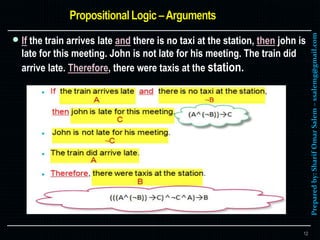
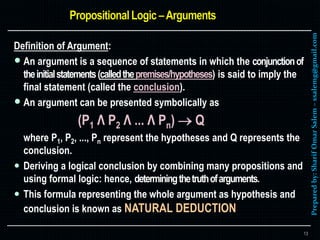


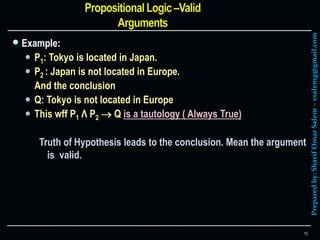







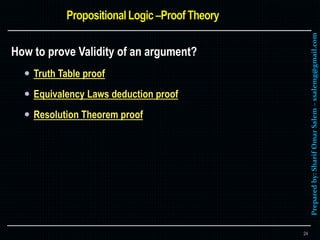

![Preparedby:SharifOmarSalem–ssalemg@gmail.com
Argument Formula:
F1 ˄ F2 ˄ F3 F4
(H A) ˄ (C G) ˄ [¬(H ˅ C) M] [¬(A ˅ G) M]
Truth Table proof
26](https://image.slidesharecdn.com/3formalmethodspropositionallogic-150220200040-conversion-gate02/85/3-formal-methods-propositional-logic-27-320.jpg)



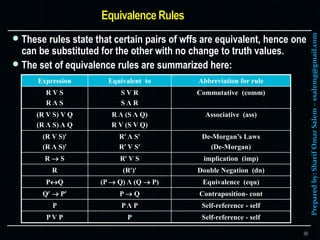





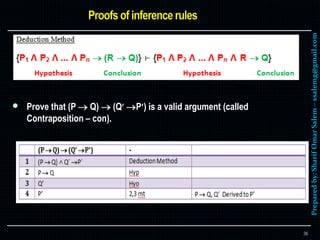
![Preparedby:SharifOmarSalem–ssalemg@gmail.com
Prove the argument
A Λ (B C) Λ [(A Λ B) (D V C)] Λ B D
37](https://image.slidesharecdn.com/3formalmethodspropositionallogic-150220200040-conversion-gate02/85/3-formal-methods-propositional-logic-38-320.jpg)
![Preparedby:SharifOmarSalem–ssalemg@gmail.com
Prove the argument
A Λ (B C) Λ [(A Λ B) (D V C)] Λ B D
First, write down all the hypotheses.
1. A
2. B C
3. (A Λ B) (D V C)
4. B
38](https://image.slidesharecdn.com/3formalmethodspropositionallogic-150220200040-conversion-gate02/85/3-formal-methods-propositional-logic-39-320.jpg)
![Preparedby:SharifOmarSalem–ssalemg@gmail.com
Prove the argument
A Λ (B C) Λ [(A Λ B) (D V C)] Λ B D
First, write down all the hypotheses.
1. A
2. B C
3. (A Λ B) (D V C)
4. B
Use the inference and equivalence rules to get at the conclusion D.
5. C 2,4, mp
6. A Λ B 1,4, con
7. D V C 3,6, mp
8. C V D 7, comm
9. C D 8, imp
and finally
10. D 5,9 imp
The idea is to keep focused on the result and sometimes it is very easy to go
down a longer path than necessary.
39](https://image.slidesharecdn.com/3formalmethodspropositionallogic-150220200040-conversion-gate02/85/3-formal-methods-propositional-logic-40-320.jpg)



